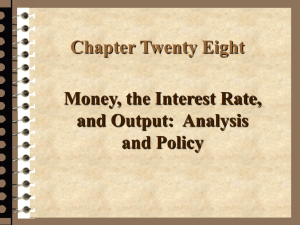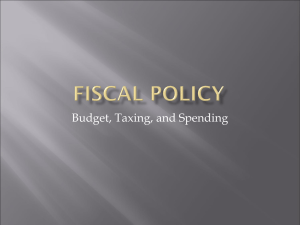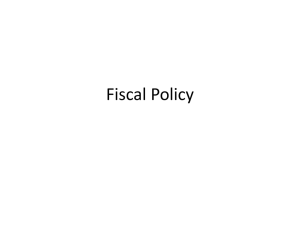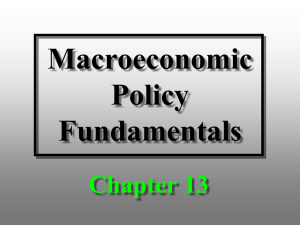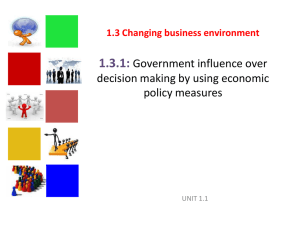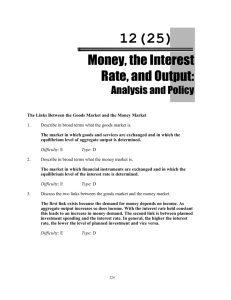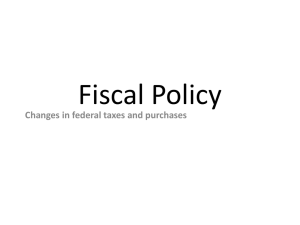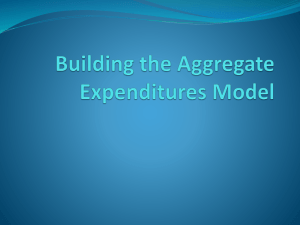Macroeconomic Fundamentals Aggregate demand product market
advertisement
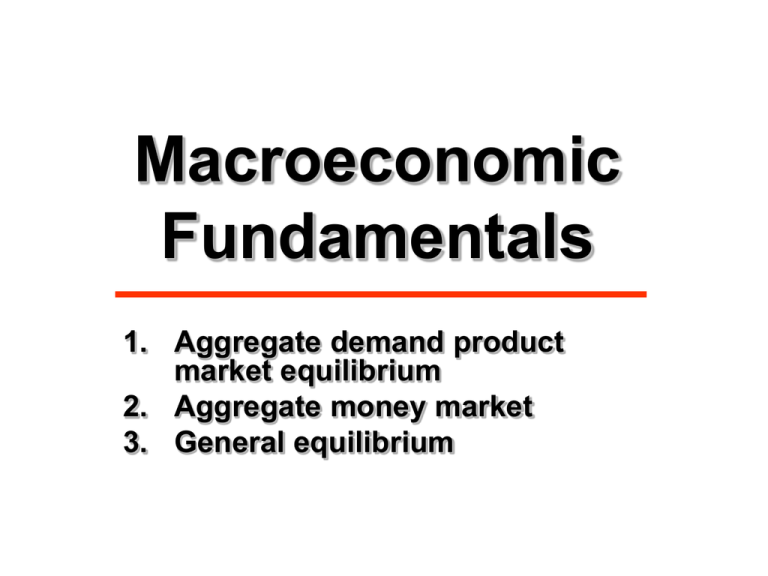
Macroeconomic Fundamentals 1. Aggregate demand product market equilibrium 2. Aggregate money market 3. General equilibrium Above average global GDP growth rates in 6 of last 8 years 1988-97 Ave. 1998 1999 2000 2001 2002 2003 2004 2005 2006 World 3.4 2.8 3.7 4.9 2.6 3.1 4.1 5.3 4.9 5.1 Africa 2.3 2.8 2.7 3.1 4.2 3.6 4.6 5.5 5.4 5.4 Central and Eastern Europe 0.9 2.9 0.7 5.1 0.3 4.5 4.7 6.5 5.4 5.3 Middle East 4.0 3.7 1.8 5.3 3.0 4.1 6.4 5.5 5.7 5.8 China 9.9 7.8 7.1 8.4 8.3 9.1 10.0 10.1 10.2 10.0 India 6.0 5.9 6.9 5.3 4.1 4.3 7.2 8.0 8.5 8.3 Other emerging market and developing countries 4.1 3.0 4.1 6.1 4.4 5.1 6.7 7.7 7.4 7.3 United States 3.0 4.2 4.5 3.7 0.8 1.6 2.5 3.9 3.2 3.4 Sources: US Department of Commerce and International Monetary Fund. Components of Aggregate Demand: Aggregate demand is defined as the sum of consumption spending (C), investment spending (I), Government spending (G), and net exports (X-M); X represents exports and M represents imports. Aggregate demand, referred to as Gross domestic product or GDP, is therefore given by: AD = GDP = C + I + G + X – M The economy is said to be in general equilibrium when the money, labor and product markets are all in equilibrium. Focus here is on the short run. Equilibrium in the Money Market Interest Rate MD MS LM i3 i2 iE i1 M Quantity of Money Page 98 Y1 Y2 Y3 Gross Domestic Product Page 93 Definition of LM: L represents the demand for liquidity and M represents the quantity of money At all points along the LM curve, the demand for money equals supply. Product Market Equilibrium General Price Level IS AD AS i3 i2 i1 PE YE YPOT Y3 Y2 Y1 Gross Domestic Product Gross Domestic Product Page 97 Page 94 Definition of IS: I represents the investment spending and S represents savings. At all points along the IS curve, investment equals savings. Three Ranges of Aggregate SR Supply Curve Normal range General Price Level Depression range AS Classical range YPOT Gross Domestic Product Page 97 Potential GDP in the current year Note: The aggregate production function for the general economy is: Y = f(L,K) where L is the employed labor force, and K is the capital stock. General Price Level Elasticity of SR Aggregate Supply Curve AD AS AD AS ∆PE ∆PE ∆YE YPOT ∆YE YPOT Gross Domestic Product Gross Domestic Product Page 97 Page 97 Elasticity of the short run aggregate supply curve in the normal range will help determine the rate of demand pull inflation in the economy, given by the percent change in the general price level or (∆PE/PE). Interest Rate MD IS MS LM iE iE YE Quantity of Money General Equilibrium in the money and product markets General Price Level M AD AS PE YE YPOT Gross Domestic Product Page 97 Equilibrium in Labor Market Labor Market AD LD AS LS Wage Rate General Price Level Product Market ∆PE ∆YE YPOT Gross Domestic Product Page 97 ∆WRE ∆LE LMAX Employment Page 98 The aggregate demand for goods and services in the product market drives the demand for labor in the nation’s labor market. Phillips Curve Tradeoff in Short Run Unemployment Rate Expansionary Policy Impact UR Contractionary Policy Impact UR INF Inflation Rate INF Inflation Rate This curve initially proposed by the English economist William Phillips tracks the short run tradeoff between unemployment and inflation. Expansionary Fiscal policy Action: cut tax rates and/or raise government spending Expansionary Monetary policy Action: increase money supply Interest Rate IS IS LM IS* LM LM* i i Y Gross Domestic Product Page 95 Y Gross Domestic Product Page 96 Hint: Contractionary monetary and fiscal policy actions have the exact opposite effects of expansionary policy actions. Expansionary Monetary policy Action: increase money supply Interest Rate IS Expansionary monetary policy lowers interest rates, stimulates investment spending, increases aggregate demand for goods and services, can increase the general price level, increases the need for additional labor to produce additional goods and services, and can increase the wage rates. Does not occur instantaneously. LM LM* i AD AD* AS LD Wage Rate General Price Level YE ∆PE ∆YE YPOT Gross Domestic Product LD* LS ∆WRE ∆LE LMAX Employment Expansionary Fiscal policy Action: cut tax rates or raise government spending Interest Rate IS IS* Expansionary fiscal policy leads to government borrowing, raising interest rates, but stimulates aggregate demand for goods and services, can increase the general price level, increases the need for additional labor to produce additional goods and services, and can increase the wage rates. Does not occur instantaneously. LM i YE LD AS LS Wage Rate General Price Level AD ∆PE ∆YE YPOT Gross Domestic Product ∆WRE ∆LE LMAX Employment Full Employment and GDP Gaps Recessionary GDP Gap AS AD PE YE YPOT YFE Use expansionary policy to eliminate SR recessionary gap: 1. Lower interest rates 2. Cut taxes 3. Increase government spending Full Employment and GDP Gaps Recessionary GDP Gap Inflationary GDP Gap AD AS AD AS PE PE YE YPOT YE YPOT YFE Use expansionary policy to eliminate SR recessionary gap: 1. Lower interest rates 2. Cut taxes 3. Increase government spending YFE Use contractionary policy to eliminate SR inflationary gap: 1. Raise interest rates 2. Raise taxes 3. Decrease government spending Policy Impacts on Macro Economy “Big 5” macro Economic variables Expansionary Monetary Policy Contractionary Monetary Policy Expansionary Fiscal Policy Contractionary Fiscal Policy Interest rate Lower Higher Higher Lower GDP growth rate Higher Lower Higher Lower Unemployment rate Lower Higher Lower Higher Inflation rate Higher Lower Higher Lower Exchange rate Lower Higher Higher Lower Impact of macroeconomic policy on five variables important to the nation’s food and fiber Industry Page 101 Macro – Market – Micro Note: This does not occur instantaneously. Page 102 Note: This does not occur instantaneously. Page 103 Policy Impacts on the Farm Sector Farm sector variables Expansionary Monetary Policy Contractionary Monetary Policy Expansionary Fiscal Policy Contractionary Fiscal Policy Farm revenue Higher Lower Higher Lower Farm expenses Higher Lower Higher Lower Net farm income Higher Lower Higher Lower Farm land values Higher Lower Higher Lower Exports Higher Lower Lower Higher Impact of macroeconomic policy on five variables important to the nation’s farm sector Page 104 What is Next? We have covered the topic of market equilibrium for a specific commodity. We have also covered the topic of general equilibrium and GDP gaps. Let’s now look at policy actions we would expect from policymakers and their impact on individual markets at the economy level. Any Questions?

